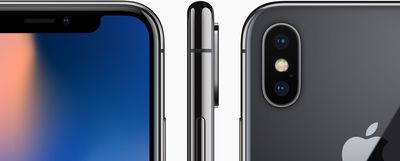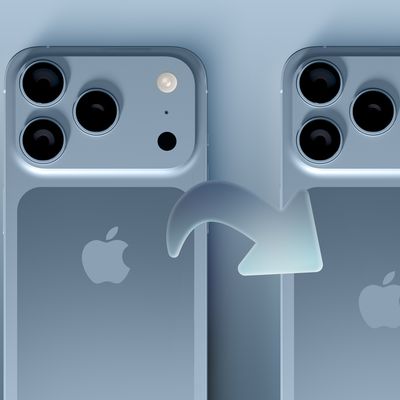Apple Reportedly Working on 3D Sensor System for Rear Camera in 2019 iPhones
Apple is developing 3D depth sensing technology for the rear-facing cameras in its 2019 iPhones, according to a new report by Bloomberg on Tuesday. The 3D sensor system will be different to the one found in the iPhone X's front-facing camera, and is said to be the next big step in turning the smartphone into a leading augmented reality device.

Apple is evaluating a different technology from the one it currently uses in the TrueDepth sensor system on the front of the iPhone X, the people said. The existing system relies on a structured-light technique that projects a pattern of 30,000 laser dots onto a user's face and measures the distortion to generate an accurate 3D image for authentication. The planned rear-facing sensor would instead use a time-of-flight approach that calculates the time it takes for a laser to bounce off surrounding objects to create a three-dimensional picture of the environment.
The existing TrueDepth camera would continue to be used in the front-facing camera of future iPhones in order to power Face ID, while the new system would bring the more advanced "time-of-flight" 3D sensing capability to the rear camera, according to the sources cited. Discussions with manufacturers are reportedly already underway, and include Infineon, Sony, STMicroelectronics, and Panasonic. Testing is said to be still in the early stages, and could end up not being used in the phones at all.
With the release of iOS 11, Apple introduced the ARKit software framework that allows iPhone developers to build augmented reality experiences into their apps. The addition of a rear-facing 3D sensor could theoretically increase the ability for virtual objects to interact with environments and enhance the illusion of solidity.
Apple was reportedly beset with production problems when making the sensor in the iPhone X's front-facing camera, because the components used in the sensor array have to be assembled with a very high degree of accuracy. According to Bloomberg, while the time-of-flight technology uses a more advanced image sensor than the existing one in the iPhone X, it does not require the same level of precision during assembly. That fact alone could make a rear-facing 3D sensor easier to produce at high volume.
Late last month, oft-reliable KGI Securities analyst Ming-Chi Kuo claimed that Apple is unlikely to expand its front-facing 3D sensing system to the rear-facing camera module on iPhones released in 2018. Kuo said the iPhone X's 3D sensing capabilities are already at least one year ahead of Android smartphones, therefore he believes Apple's focus with next year's iPhone models will be ensuring an on-time launch with adequate supply.
Popular Stories
Apple's next-generation iPhone 17 Pro and iPhone 17 Pro Max are less than three months away, and there are plenty of rumors about the devices.
Apple is expected to launch the iPhone 17, iPhone 17 Air, iPhone 17 Pro, and iPhone 17 Pro Max in September this year.
Below, we recap key changes rumored for the iPhone 17 Pro models:Aluminum frame: iPhone 17 Pro models are rumored to have an...
The long wait for an Apple Watch Ultra 3 appears to be nearly over, and it is rumored to feature both satellite connectivity and 5G support.
Apple Watch Ultra's existing Night Mode
In his latest Power On newsletter, Bloomberg's Mark Gurman said that the Apple Watch Ultra 3 is on track to launch this year with "significant" new features, including satellite connectivity, which would let you...
The upcoming iPhone 17 Pro and iPhone 17 Pro Max are rumored to have a slightly different MagSafe magnet layout compared to existing iPhone models, and a leaked photo has offered a closer look at the supposed new design.
The leaker Majin Bu today shared a photo of alleged MagSafe magnet arrays for third-party iPhone 17 Pro cases. On existing iPhone models with MagSafe, the magnets form a...
iOS 26 and iPadOS 26 add a smaller yet useful Wi-Fi feature to iPhones and iPads.
As spotted by Creative Strategies analyst Max Weinbach, sign-in details for captive Wi-Fi networks are now synced across iPhones and iPads running iOS 26 and iPadOS 26. For example, while Weinbach was staying at a Hilton hotel, his iPhone prompted him to fill in Wi-Fi details from his iPad that was already...
The iPhone 17 Pro Max will feature the biggest ever battery in an iPhone, according to the Weibo leaker known as "Instant Digital."
In a new post, the leaker listed the battery capacities of the iPhone 11 Pro Max through to the iPhone 16 Pro Max, and added that the iPhone 17 Pro Max will feature a battery capacity of 5,000mAh:
iPhone 11 Pro Max: 3,969mAh
iPhone 12 Pro Max: 3,687mAh...
Apple today seeded the second betas of upcoming iOS 18.6 and iPadOS 18.6 updates to public beta testers, with the betas coming just a day after Apple provided the betas to developers. Apple has also released a second beta of macOS Sequoia 15.6.
Testers who have signed up for beta updates through Apple's beta site can download iOS 18.6 and iPadOS 18.6 from the Settings app on a compatible...
Apple is developing a MacBook with the A18 Pro chip, according to findings in backend code uncovered by MacRumors.
Subscribe to the MacRumors YouTube channel for more videos.
Earlier today, Apple analyst Ming-Chi Kuo reported that Apple is planning to launch a low-cost MacBook powered by an iPhone chip. The machine is expected to feature a 13-inch display, the A18 Pro chip, and color options...





















